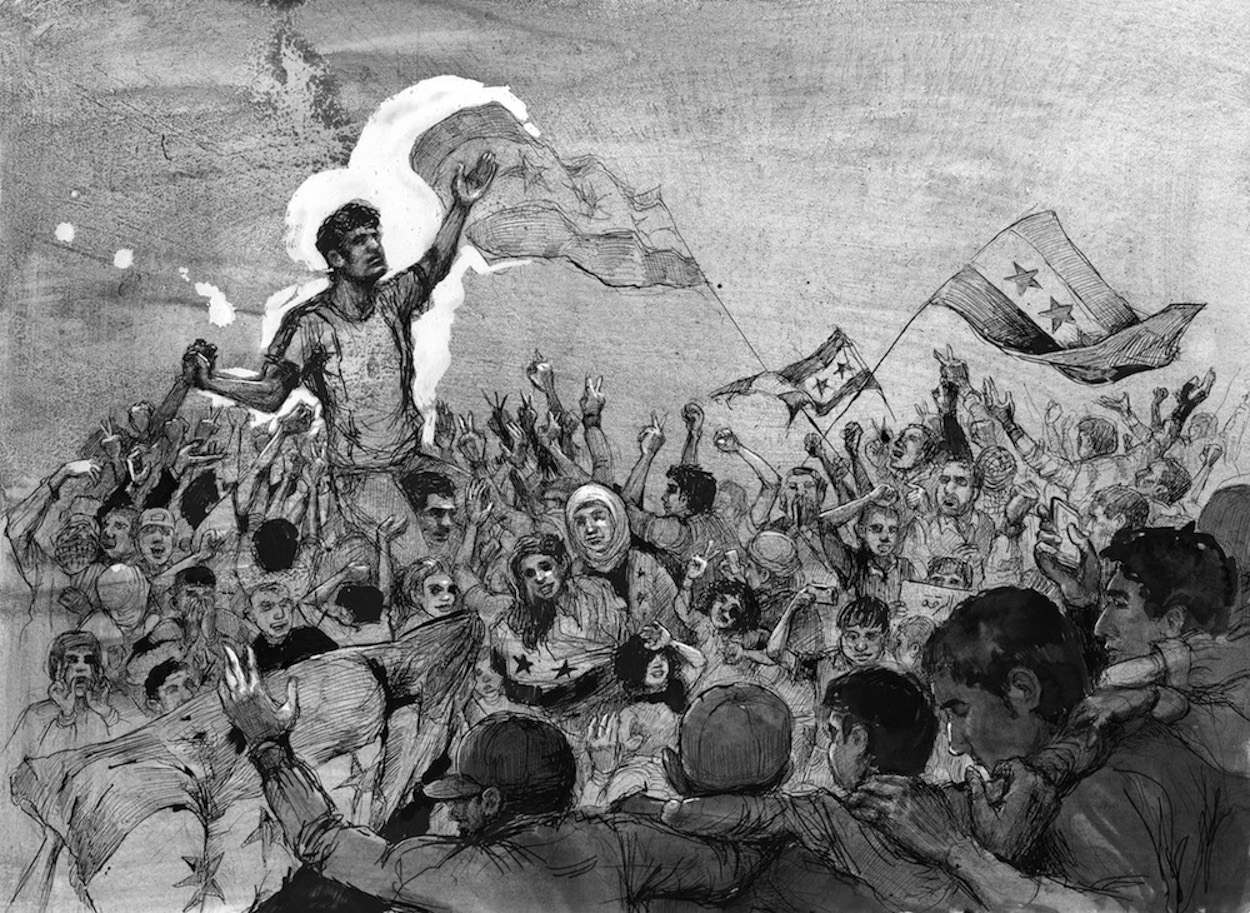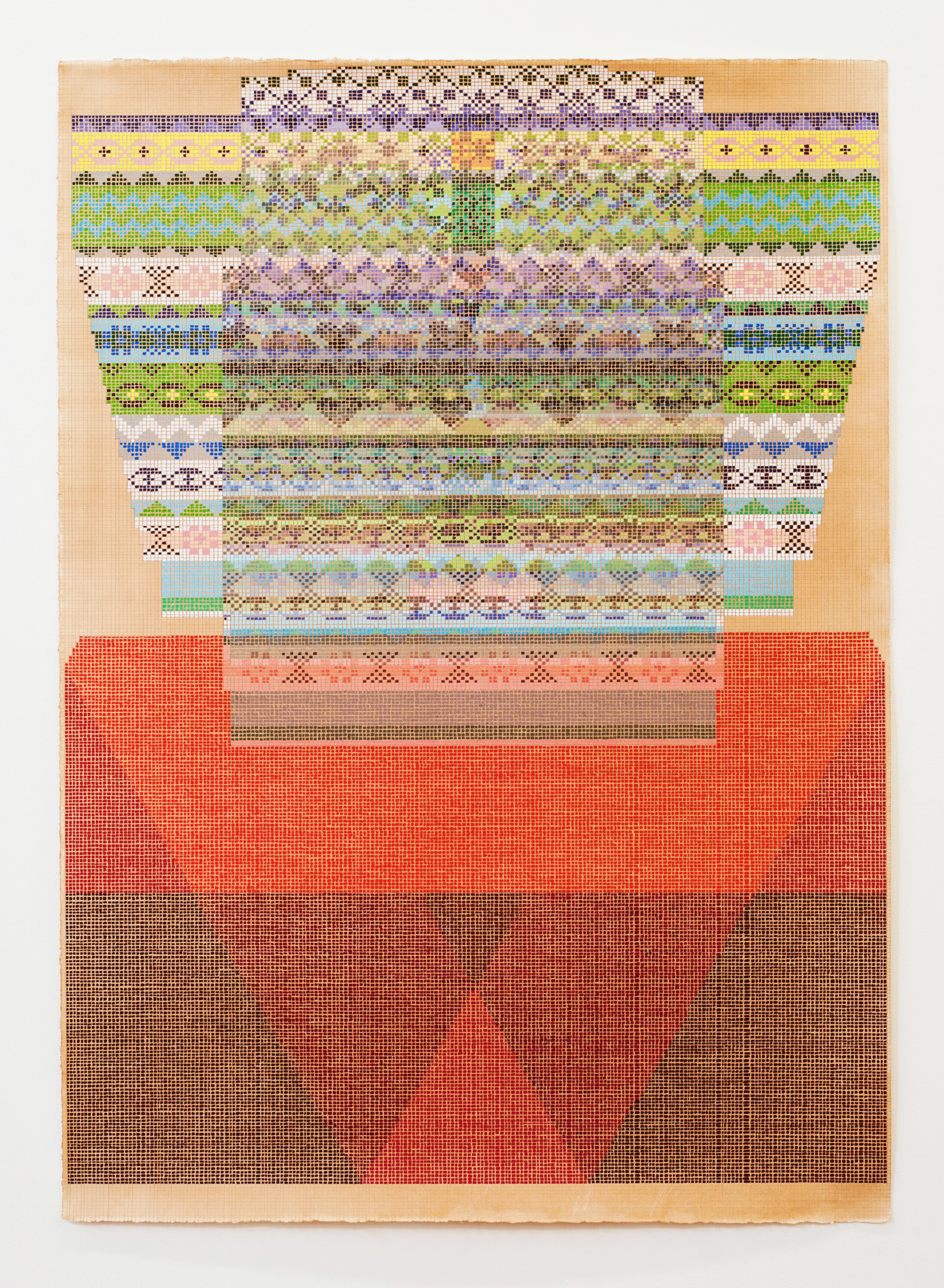Paper Mirror: Nancy Spero

Nancy Spero (1926-2009) was an American artist and activist who subverted aesthetic orthodoxies by reframing the historical imaging of women. Paper Mirror, Spero’s first retrospective since her death, is on view at MOMA PS1 through June 23.
Words by Juliet Vincente
Fighting the myth of female inferiority for more than forty years, Nancy Spero (1926-2009) devoted her career to making art that responded to the political turmoil of the 20th century. The first retrospective since her death, Paper Mirror: Nancy Spero starts with her opaque Black Paintings from the 1960s and culminates in her final, monumental sculpture for the 2007 Venice Biennale, Maypole: Take No Prisoners. Curated by Julie Ault and supplemented by Irene Sosa’s films, the exhibition presents Spero firm in her conviction that the sharpest criticism of sexism and violence was to displace the noise with her own vision.
Nancy Spero. The Goddess Nut II. 1990 . Handprinting and printed collage on paper. Five panels: 213.4 x 279.4 cm (7 feet x 9 feet, 2 inches) overall. © 2019 The Nancy Spero and Leon Golub Foundation for the Arts/Licensed by VAGA at ARS, NY, courtesy Galerie Lelong & Co. Photo: Michael Bodycomb
Nancy Spero. Sheela-Na-Gig. 1991. Handprinted collage on paper. 64.8 x 47 cm (25.5 x 18.5 inches). © 2019 The Nancy Spero and Leon Golub Foundation for the Arts/Licensed by VAGA at ARS, NY, courtesy Galerie Lelong & Co. Photo: Christopher Burke Studio
“Resisting reduction, Spero constructed narratives that re-contextualized and complicated notions of violence and femininity.”
Running the length of the central gallery’s walls, her immersive paper friezes read like sculptural reliefs on ancient temples, depicting rhythmic processionals of female figures. Drawing from sources that span Troy to Vietnam, Sheela na gigs and Egyptian mourners are given new purpose when juxtaposed with Olympic athletes. Throughout her career, Spero subversively suggested that the facts of history are mutable and forged a new kind of hieroglyph in her work. Resisting reduction, Spero constructed narratives that re-contextualized and complicated notions of violence and femininity. Rather than offering personal insight, her work intends to inspire diverse interpretations.
With her Black Paintings, Spero began creating the mysterious visual language that characterizes much of her practice. In her reflection “Creation and Procreation” (1992), Spero discusses how early in her career in Paris, as the wife of painter Leon Golub and mother of three sons, she found time to make art at night, a habit she continued. The Black Paintings depict murky images of couples copulating and mothers shuttling knee high children, their expressions hidden under heavy brushstrokes in hues that range from soot to midnight. These nocturnal and lonely canvases are the last glimpse we have of Spero’s introspection – from her 1966 declaration that painting was “too establishment” onward, she turned her gaze outward.
Nancy Spero. Nightmare Figures II. 1961 . Oil on canvas . 129.5 x 160 cm (51 x 63 inches). © 2019 The Nancy Spero and Leon Golub Foundation for the Arts/Licensed by VAGA at ARS, NY, courtesy Galerie Lelong & Co. Photo: Christopher Burke Studio.
Spero began exclusively using ink and gouache on paper to make drawings that captured reactions to the Vietnam War. She embraced paper for its fragility and immediacy – red ink oozes out of her quick and masterful drawings of victims. The drawings were intended be pinned directly to the wall - manifesto style. Made following Spero’s relocation to New York, the War Series marks a radical departure for Spero in her formal practice, but also displays a rejection of broader artworld trends. As her husband Golub and artist peers created larger paintings, Spero went smaller. She chose to use less precious materials, it seems, to provoke people to question the value of her work. Petite and precise, the War Series is incisive in its overarching condemnation of violence.
Nancy Spero. Male Bomb I. 1966 . Gouache and ink on paper . 86.4 x 68.6 cm (34 x 27 inches). © 2019 The Nancy Spero and Leon Golub Foundation for the Arts/Licensed by VAGA at ARS, NY, courtesy Galerie Lelong & Co. Photo: Christopher Burke Studio
Up until the late 1960s, female artists were, by and large, ignored. From 1969-1974, she devoted herself to exclusively making work about French avant-garde playwright Antonin Artaud, a fellow outcast. Dismissed on the basis of her sex, Spero was fascinated by Artaud’s male suffering on the fringes of society. Working from his writings, she created obscure, impenetrable drawings that paired excerpts of text collaged with imagery – the severed head with extended tongue, for example - she would go on to revisit throughout her career.
While Spero enjoyed ambiguity on the pictorial plane, she was steadfast in her advocacy. She sought to create space, for herself and other female artists, free from the dominance of men. Spero joined artist-activist groups the Art Workers Coalition and Women Artists in Revolution and was a founding member of A.I.R. Gallery (Artists in Residence, Inc.). Established by and for female artists in 1972, A.I.R. Gallery in Soho still runs as a non-profit art space only for women-identifying artists.
“From villains, victims to virgins, Spero’s rapacious research shows an artist in desperate pursuit of a new definition of femininity.”
Nancy Spero. Artemis, Goddess and Centaur. 1983. Handprinting on paper . 71.1 x 50.8 cm (28 x 20 inches). © 2019 The Nancy Spero and Leon Golub Foundation for the Arts/Licensed by VAGA at ARS, NY, courtesy Galerie Lelong & Co. Photo: Christopher Burke Studio
In 1974, Spero resolved to exclusively explore the story of the female protagonist, realized in In Notes in Time on Women (1979). A monumental multi-paneled, multimedia work on paper, in Notes, Spero conflates the history of female subjugation across cultures. Separated in individual, horizontal friezes, the work provides condensed narrative arcs of life under the patriarchy. Examples include first menstruation to messy divorce, creation myth to Sojourner Truth, Abigail Adams to Barry Goldwater. Spero transferred her drawings of Hellenic goddesses and pop culture icons onto zinc plates, which allowed her to quickly reproduce her favorite “characters” or “stars,” as she calls them, over large areas ad infinitum. Lyrical compositions are punctuated with 94 quotes lifted from newspapers and texts like H.D.’s Helen in Egypt (1961) and the Malleus Maleficarum (1487). From villains, victims to virgins, Spero’s rapacious research shows an artist in desperate pursuit of a new definition of femininity. Envisioned as a liberation and celebration of women’s indomitable spirit, Notes is Spero’s revisionist feminist history.
In her final work, Maypole: Take No Prisoners, Spero gives her own work the same treatment, “cannibalizing” her previous drawings for a new purpose. Using imagery dating back to her War Series, her “stars” are recast as severed, shrieking heads that hover, bloody like lynched victims from red ribbons and chains off the central Maypole, the work is immersive and casts chaotic shadows. Made against the backdrop of the Iraq War, Spero subverts this traditional festive symbol used to welcome the entry of spring to a meditation on the absurdity of war.
During the making of Maypole, Spero was asked in an interview to recount her grievances. She couldn’t locate one source for her discontent, saying instead: “I don’t know if it’s railing against the world or something, but I am protesting. And as an artist, I am privileged to create things the way I think they should be.”
Paper Mirror is on view at MOMA PS1 through June 23rd. Free for NYC residents.
Author account for the Good Trouble hive-mind.










